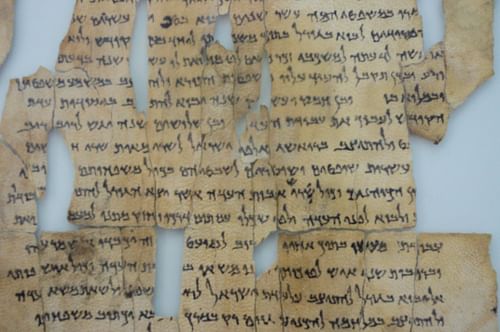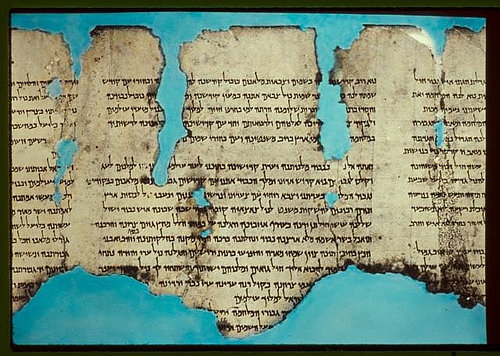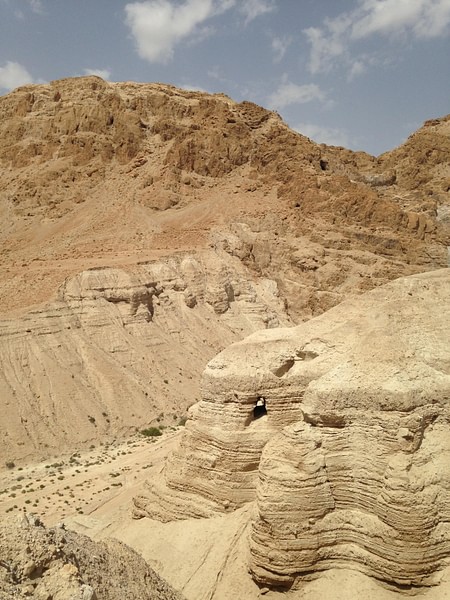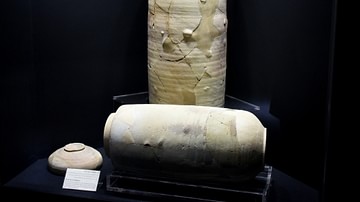
The Dead Sea Scrolls (DSS) are a collection of scrolls found in the desert east of Jerusalem on the shore of the Dead Sea. They represent the largest manuscript collections of texts from the Second Temple Period found in the area of Judah, an area notorious for its lack of manuscripts. Around 930 texts were found in 11 caves in the hills surrounding Khirbet (=ruins of) Qumran. The texts are the product of a community of Essenes who lived in the nearby ruins of Qumran and were composed between the 3rd century BCE and the 1st century CE. They are significant because they shed considerable light on the religious and political world of late Second Temple Judaism and on the text of the Hebrew Bible.
Survey of Manuscripts
The DSS have been given a standardized numbering system illustrated as follows:
There is a commentary (known as a pesher, see below) on Nahum. The text is numbered as 4Q169. It was the 169th manuscript found in cave 4. All manuscripts follow this standardized number system. There are a few exceptions. For example, the Great Isaiah Scroll, one of the first manuscripts found, is numbered as 1QIsaa. Note that it is still given the numbering 1Q (meaning it was found Cave 1).
Biblical Scrolls
The term “biblical” is inappropriate when applied to the DSS because “the Bible” as we know it today did not exist in Second Temple Judaism (515 BCE-70 CE). Rather than denoting a set of texts with a special level of authority, “biblical scrolls” refers to those texts found in the Tanakh/Hebrew Bible/Protestant Old Testament. This is a classification imposed upon the DSS by later scholars.
Among the DSS, every book of the Hebrew Bible has been found except for Esther. However, not all books are equally attested. The Psalms (34 different scrolls), Deuteronomy (30), Isaiah (21), and Genesis (20) are the four most prevalent biblical scrolls. Eccleasties has only two different scrolls, and Ezra, Nehmiah, and Chronicles only have one scroll each.
The biblical scrolls found among the DSS represented a significant opportunity to study the text of the standard Hebrew Bible, the Masoretic Text. For example, the version of Jeremiah found in the Septuagint (the Greek Translation of the Hebrew Bible) is one eighth shorter than that found in the Masoretic Text. It was initially thought that the Septuagint represented a poor translation. However, Hebrew versions of both the longer and shorter versions have been found among the DSS. Contrary to the claims of some, no single New Testament manuscript has been found among the DSS.
Targumim
Targumim (plural of targum) are special Aramaic translations and interpretations (targum in Hebrew for “translation). A highly fragmentary targum of Leviticus and two targumim of Job (one, 11Q10, is one of the most complete manuscripts) have been found among the DSS. These finds are significant because they reframed the debate regarding how early the targumim were written down. Until 1947, we had no evidence of a targum written down before the Common Era.
Apocryphal and Pseudepigraphical Scrolls
Like “biblical” this classification is anachronistic, but useful. It designates works that were not biblical in the sense of becoming part of the Hebrew Bible nor are unique to the Qumran community. This group of texts includes things such as the Psalm 151, a psalm only appearing in Greek until its discovery among the Dead Sea Scrolls (11QPsa), Jewish apocalyptic (on apocalypticism see the definition on the Qumran Essenes) works such as 1 Enoch and Jubilees (both of which outnumber individual biblical scrolls).
Pesherim
Pesherim (plural of pesher) are special running commentaries on various prophetic texts and the Psalms of the Hebrew Bible. In contrast to the targumim, these commentaries are written in Hebrew and are aimed specifically at the Qumran community and are written in Hebrew.
Thematic Commentaries
While the pesharim are running commentaries, these commentaries draw on the various texts of the Hebrew Bible and are focused on a specific theme or themes, particularly the end of the current age.

Paraphrases
A number of paraphrases were found among the DSS, mostly on the Torah (e.g. 4Q127, a Greek paraphrase of Exodus) and the Historical Books (e.g. 4Q382, a paraphrase of Kings).
Legal Scrolls
Several legal texts have been found among the DSS. These are among the most important texts for understanding not only the Qumran Community, but also Jewish legal interpretation of the Second Temple Period in general. Some of the texts (e.g. The Temple Scroll [11Q19 is the best-preserved copy] and the Rule of the Community [1QS is the best-preserved copy]) are specifically for the Qumran community. Others are meant not only for a sectarian community, but also for Essenes living in the towns and cities of Judea (e.g. the Damascus Document).
Scrolls for use in Worship
While books like the Psalms functioned as resources used in worship, a number of original works, some of which were clearly meant to resemble the Psalms.
Eschatological Scrolls
The Qumran Essenes were an eschatological community. Briefly described, eschatology is a belief that the end of the current age is near. Eschatological communities would order their beliefs and practices. In addition to popular Jewish eschatological texts as 1 Enoch and Jubilees, the Qumran community produced a number of works regarding the final days. Some works focus on the days running up to the end (e.g. the War Scroll [1QM]). Others are concerned with the new age, particularly with the new Jerusalem and a newly rebuilt temple (e.g 1Q32, 2Q24, 4Q232, 4Q554).
Wisdom Scrolls
A number of works are reminiscent of canonical wisdom works such as Psalms and Proverbs. Though these works are closely related to wisdom literature, they are still eschatological in nature, focusing on the end times and right actions for the community.
The Copper Scroll (3Q15)
This final scroll is an enigma. No scholar is certain what it is, what it means, or how it functioned in the community. First of all, it is engraved on copper suggesting that this was originally not meant as a scroll. Second, though it was found in cave three, it was found apart from the rest of the scrolls, suggesting it might have been a separate deposit in the cave. Third, once it was finally unrolled and translated, the text appeared to be a treasure map written in Hebrew, but with random Greek letters placed throughout the text. John Marco Allegro, an early scrolls scholar, thought it was a literal treasure map and attempted to find what he thought was the hidden riches of the Qumran community. However, due to the fact that a number of the locations in the text are unknown, he was unsuccessful. Some scholars continue to maintain that it is still a literal treasure map. Others think it is a work of fiction. The Copper Scroll remains an enigma with no consensus forming about its interpretation or function in the Qumran community.
Discovery
The discovery of the scrolls is a convoluted story which must be presented in a very brief manner here.
In late 1946 or 1947 CE, three Bedouin (a nomadic Arab ethnic group) wandering in the desert along the Northwest shore of the Dead Sea along the Wadi Qumran stumbled across a cave containing ten jars. All but two of which were empty. One contained dirt, but the other contained what later proved to be the Great Isaiah Scroll, a rule book called The Manual of Discipline (or the Rule of the Community), and a commentary on the biblical book of Habakkuk. Later four other scrolls were found by the Bedouin. It took nearly a year before the scholarly world was made aware of the existence of these seven manuscripts, though the original seven would remain in two separate collections until 1954 CE.
Once the Bedouin realized the value of the manuscripts they began combing the hills around Khirbet Qumran in search of other caves. The next cave was not found until February 1952 CE (Cave 2). Archeologists found their first cave in March (Cave3). The most spectacular find came in September 1952 when two archaeologists, following the tip of some Bedouin, excavated Cave 4. Cave 4 yielded around 100 different manuscripts. Following Cave 4, another seven caves were found. The final cave (Cave 11) was found in 1956 CE. There were subsequent attempts by archaeologists to find more caves containing manuscripts but none have been found.
With the flurry of manuscript discoveries, included a number of finds dating from the Bar Kokhba Rebellion (132-136 CE), it is only natural that with it came an interest in the ruins near the caves. Six seasons of excavations took place at Khirbet Qumran between 1951 and 1958 CE.








